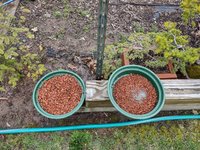The first article was very specific. It concerns the use of DE solely against insect pests in the stored grain (see “dry”) environment and never even touches on mycological implications. That said, if I ever have a silo of corn or barley and I’m dealing with weevils DE will be a top consideration.
With regards to the second article. This was the only one to state outright; “Yes, diatomaceous earth kills fungus”. However… a) This is a non-scientific article. b) The only scientific article linked (via a hypertext link) was about the effects of DE on external, insect parasites on laying hens in the free range environment. c) This article does not even include a bibliography to back up claims with actual research. d) In place of a bibliography this statement was found; “GardeningBank.com is a participant in the Amazon Services LLC Associates Program. As an Amazon Associate, we earn from qualifying purchases.”, which in my opinion renders it useless as unbiased research.
I did some more poking around the web for the source of the fungicidal claim and the only scientific sources I could find concerning this issue suggested that DE as a soil component could be a prophylactic fungicide by killing fungus gnats within the soil and thus preventing the spread of harmful fungus BUT the paper concluded that it was actually ineffective against larval gnats.
In summary, I’m open to new information of the non-anecdotal variety but for now I will continue to use DE as a primary soil component and would feel ok suggesting it to others based on my personal experience. Attached is the DE/fungus gnat paper. It’s very “dry” reading but informative.
https://journals.ashs.org/downloadpdf/journals/hortsci/40/6/article-p1806.pdf
I don’t know if the following will put this issue to bed but I feel it is important to note that the product “Rootella X” is a mycorrhizal inoculant for large scale farm applications. The vehicle for the fungal inoculant is, you guessed it, diatomaceous earth, in fact the product is 70% DE with the remaining 30% being the fungal spores. I think we could all agree that a company would probably not package their mycorrhizal inoculant in a fungicide.
https://www.groundworkbioag.com/wp-content/uploads/2021/02/GW181002_Rootella_X.pdf
With regards to the second article. This was the only one to state outright; “Yes, diatomaceous earth kills fungus”. However… a) This is a non-scientific article. b) The only scientific article linked (via a hypertext link) was about the effects of DE on external, insect parasites on laying hens in the free range environment. c) This article does not even include a bibliography to back up claims with actual research. d) In place of a bibliography this statement was found; “GardeningBank.com is a participant in the Amazon Services LLC Associates Program. As an Amazon Associate, we earn from qualifying purchases.”, which in my opinion renders it useless as unbiased research.
I did some more poking around the web for the source of the fungicidal claim and the only scientific sources I could find concerning this issue suggested that DE as a soil component could be a prophylactic fungicide by killing fungus gnats within the soil and thus preventing the spread of harmful fungus BUT the paper concluded that it was actually ineffective against larval gnats.
In summary, I’m open to new information of the non-anecdotal variety but for now I will continue to use DE as a primary soil component and would feel ok suggesting it to others based on my personal experience. Attached is the DE/fungus gnat paper. It’s very “dry” reading but informative.
https://journals.ashs.org/downloadpdf/journals/hortsci/40/6/article-p1806.pdf
I don’t know if the following will put this issue to bed but I feel it is important to note that the product “Rootella X” is a mycorrhizal inoculant for large scale farm applications. The vehicle for the fungal inoculant is, you guessed it, diatomaceous earth, in fact the product is 70% DE with the remaining 30% being the fungal spores. I think we could all agree that a company would probably not package their mycorrhizal inoculant in a fungicide.
https://www.groundworkbioag.com/wp-content/uploads/2021/02/GW181002_Rootella_X.pdf









